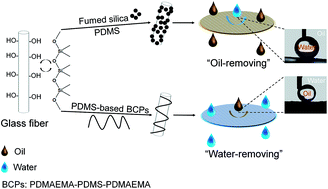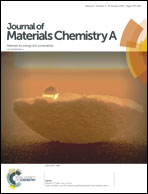Tailoring the surface chemistry and morphology of glass fiber membranes for robust oil/water separation using poly(dimethylsiloxanes) as hydrophobic molecular binders†
Abstract
An effective method to manipulate the surface chemistry and morphology of glass fibers (GF) by exploiting the strong attractive interactions between poly(dimethylsiloxane) (PDMS) and GF is reported for the first time in this paper. The effects of PDMS molar mass, annealing temperature, fumed silica and poly(N,N-dimethylaminoethyl methacrylate) (PDMAEMA) on GF's surface modification were investigated and the underlying mechanisms were elucidated. Using PDMS as a molecular binder, the SiO2 nanoparticles can be firmly anchored onto the GF surfaces to produce superhydrophobic/superoleophilic GF membranes with “oil selectivity”. Besides, PDMAEMA can readily functionalize GF surfaces through block copolymerization of PDMS, resulting in pH-responsive/underwater superoleophobic GF membranes with “water selectivity”. The superwetting membranes exhibit excellent oil/water separation performances with high separation efficiency (99%), good organic solvent resistance, and long-term stability. This approach is scalable and expected to be applied to any PDMS/glass substrate pairs to achieve customized functionalities.



 Please wait while we load your content...
Please wait while we load your content...